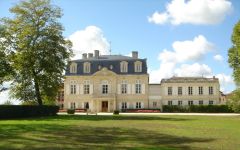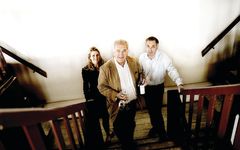Chateau Pontet-Canet 6-Pack OWC 2018
-
Robert
Parker -
Wine
Enthusiast -
James
Suckling -
Jeb
Dunnuck - Decanter


Product Details
Your Rating
Somm Note
Winemaker Notes
Professional Ratings
-
Robert Parker's Wine Advocate
Very deep purple-black in color, the 2018 Pontet-Canet rocks up with fantastically expressive plum preserves, baked blueberries and crème de cassis notes with touches of Chinese five spice, potpourri, licorice and chocolate mint plus a hint of smoked meats. Full-bodied, rich, super-concentrated and decadent, it has a firm frame of wonderfully velvety tannins with bold freshness to back up the fruit, finishing very long and very spicy.
Barrel Sample:(97-99)+ -
Wine Enthusiast
This wine is densely textured in rich tannins and beautiful fruit. Flavors of black currant and blackberry are there along with the solid structure that will allow the wine to age. This biodynamic wine has low yields in 2018 because of mildew, but what has been made is impressive and long lasting.
Barrel Sample: 96-98 -
James Suckling
A complex nose of blueberries, elderberries, dried fruit, spice and dark chocolate. It’s full-bodied with a harmonious, balanced texture. The tannins are still firm and powerful, but there’s balance and finesse to the whole thing. Tight and reserved, yet long and energetic. The tannins open slowly. Dusty texture. From biodynamically grown grapes. Try after 2024.
-
Jeb Dunnuck
Deeply colored, the 2018 Pontet-Canet checks in as a blend of 70% Cabernet Sauvignon, 22% Merlot, 5% Cabernet Franc, and the rest Petit Verdot that was destemmed by hand, fermented all in concrete tanks (punch downs only) and is still aging 55% in new French oak and the balance in concrete amphoras. It's an incredibly rich, opulent, and plush Pontet-Canet that offers loads of black and blue fruits, licorice, crushed violets, and graphite aromas and flavors. Full-bodied, powerful, beautifully textured and layered, it's reminiscent of the magical 2009 with its rare mix of both hedonistic and intellectual pleasure. Unfortunately, the estate was decimated by mildew in the spring and lost a full two-thirds of their total production. Barrel Sample: 96-98
-
Decanter
The concentration that comes from having yields of 12hl/ha is extremely clear - it makes it feel very Pauillac, again resembling as at Latour, a 2010 style in terms of its backbone and sense of hunkering down.
The fruit quality is dark and knitted, with a creamy texture if you give it a minute to settle, an obvious tannic structure and a menthol finish that lets in some juice, bramble and hedgerow pleasures. It’s clearly impressive, although I get just the slightest touch of over-concentration with hints of prune on the finish.
Barrel Sample: 96





Jean Francois Pontet, Royal Master of the Horse in the early 18th Century, bought and consolidated several plots of land located northwest of Pauillac. Several years later, in 1750, his descendants bought neighboring vineyards in an area named "Canet", thus creating one of the largest estates in the entire Medoc. Chateau Pontet-Canet's topography and soil predestined it to produce great wine.
In 1865, the noted wine shipper Hermann Cruse acquired the chateau and its 120 hectares of vones. The Cruse dynasty provided the financial means to make one of the greatest wines in the Medoc. In 1975, Guy Tesseron, solidly implanted in the Cognac region, and owner of Lafon Rochet in St-Estephe, purchsed Pontet-Canet.
The family's avowed ambition is to pass on the history of Chateau Pontet-Canet and secure its future. Today, it is Guy Tesseron’s descendants who own the estate today: Alfred and his nieces Mélanie and Philippine, daughters of his late brother Gérard. Together, they have the same outlook. Alfred shares his vision of the estate with Mélanie, passing on to her its traditions, his outlook on vinegrowing and his passion for wine.
In 2004, the year of the first biodynamic trial which took place on 14 hectares, the wines were radiant, tighter and brighter. Alfred urged Jean-Michel to go further. The estate was fully converted to biodynamic agriculture. This decision became a commitment and a challenge, but also a first for a Médoc Classified Growth.
Since then, with each vintage comes new knowledge, furthering the understanding of the terroir in a profound way. The vine’s resistance to disease is better known today, the understanding of how different parcels behave has improved, always in keeping with biodynamic principles. It requires sincerity, pragmatism and transparency: in a nutshell, absolute dedication.
The wines of Chateau Pontet-Canet obtained organic certification from Ecocert and biodynamic certification from Biodyvin in 2010 and from Demeter in 2014.
A shared state of mind and a particular sensitivity are the key factors which have propelled Chateau Pontet-Canet to the summit of Bordeaux wines in recent years. They are the expression of the Tesseron family’s quiet determination to ensure continuity over the long term.

One of the world’s most classic and popular styles of red wine, Bordeaux-inspired blends have spread from their homeland in France to nearly every corner of the New World. Typically based on either Cabernet Sauvignon or Merlot and supported by Cabernet Franc, Malbec and Petit Verdot, the best of these are densely hued, fragrant, full of fruit and boast a structure that begs for cellar time. Somm Secret—Blends from Bordeaux are generally earthier compared to those from the New World, which tend to be fruit-dominant.

The leader on the Left Bank in number of first growth classified producers within its boundaries, Pauillac has more than any of the other appellations, at three of the five. Chateau Lafite Rothschild and Mouton Rothschild border St. Estephe on its northern end and Chateau Latour is at Pauillac’s southern end, bordering St. Julien.
While the first growths are certainly some of the better producers of the Left Bank, today they often compete with some of the “lower ranked” producers (second, third, fourth, fifth growth) in quality and value. The Left Bank of Bordeaux subscribes to an arguably outdated method of classification that goes back to 1855. The finest chateaux in that year were judged on the basis of reputation and trading price; changes in rank since then have been miniscule at best. Today producers such as Chateau Pontet-Canet, Chateau Grand Puy-Lacoste, Chateau Lynch-Bages, among others (all fifth growth) offer some of the most outstanding wines in all of Bordeaux.
Defining characteristics of fine wines from Pauillac (i.e. Cabernet-based Bordeaux Blends) include inky and juicy blackcurrant, cedar or cigar box and plush or chalky tannins.
Layers of gravel in the Pauillac region are key to its wines’ character and quality. The layers offer excellent drainage in the relatively flat topography of the region allowing water to run off into “jalles” or streams, which subsequently flow off into the Gironde.
